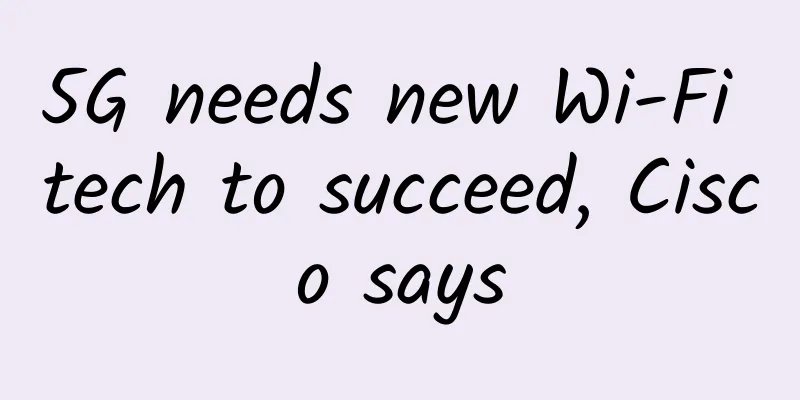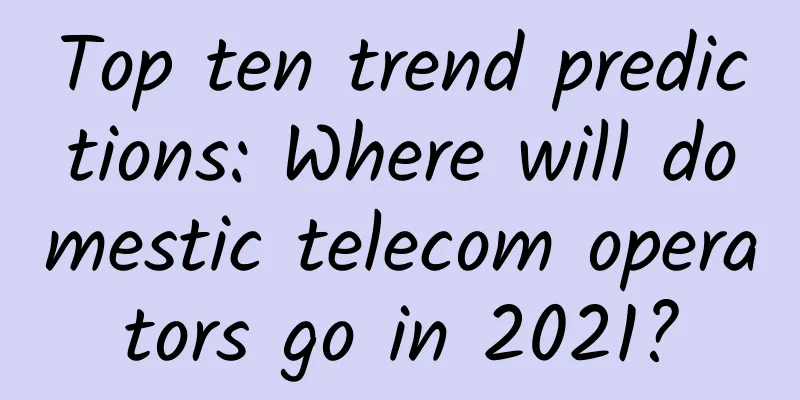Will edge computing replace cloud computing? Has the strongest dark horse in the 5G era emerged?

|
Computers are hundreds of miles apart, but the latency is only a few milliseconds. This level of latency is acceptable for office applications. But with the rise of the Internet of Things and 5G, coupled with people's endless pursuit of speed, a new type of local computing is emerging: edge computing. And edge computing isn’t just another recent fad. Arpit Joshipura, general manager of networking at the Linux Foundation, predicts that by 2025, “edge computing will replace cloud computing.”
Bridget Karlin, CTO and vice president of IBM Global Services, is less radical than Joshipura, but agrees: “We will see edge computing grow due to the sheer number of instances compared to centralized cloud centers. IBM estimates that there are about 15 billion smart devices in the market today; IDC predicts that this number will soar to 150 billion by 2025 - which will bring unprecedented amounts of data.” Lewis Carr, senior director of product marketing and management at cloud data management company Actian, agrees that edge computing will dominate. Carr believes that "edge computing will surpass cloud computing in terms of absolute computing power, data collected, and even the number of cycles applied to data processing and analysis operations at the edge, provided that we understand edge as end-to-end across all layers of the edge." “The edge cannot be understood as complex IoT devices such as smartphones and dedicated machine vision systems for specific applications. Instead, it includes a low-end mesh of IoT devices equipped with 8-bit, 16-bit and 32-bit microcontroller units, as well as remote field servers and small data centers supporting environments such as ocean-going cargo ships, forward command posts and rural hospitals.” In short, edge computing will cover the scope of homes, offices and factories. It will be everywhere. Joshipura has a very specific meaning when he talks about edge computing: It’s computing and storage resources with latency of just 5 milliseconds to 20 milliseconds. Who needs such low latency, other than an extremely active Fornite gamer? It’s needed for a new generation of hardware that’s focused on real-time work and the kinds of applications that run on that hardware. This includes manufacturing equipment monitoring, self-driving cars, telemedicine, and a whole host of devices and applications that we’re still inventing. The network traffic per device may not be large individually, but if thousands of cameras are used for video conferencing, remote medical patient diagnosis, and CCTV security monitoring, high latency and bandwidth costs can seriously hinder these applications. There are also use cases where edge computing capabilities help more successful applications. For example, Bob Gill, vice president of Gartner Research, pointed out: "Suppose there are a large number of traffic lights in a city. One of the things we can do with edge computing is to provide intelligence between devices so that they can communicate with each other without having to communicate with a central point." These new applications can function properly due to the local processing and storage capabilities at the edge. Of course, some data still needs to be sent to the cloud or a remote data center, but the amount of data sent is reduced. Open Edge Computing From Joshipura's perspective, the best way forward for edge computing is to leverage an open, interoperable framework. This framework should be independent of hardware, chips, cloud computing, or operating systems. Open edge computing should also support any edge computing use case: IoT edge, telecom edge, cloud edge, or enterprise edge, "the purpose is to unify all of these." LF Edge is on that path. This organization under the Linux Foundation strives to get all edge computing vendors to support a unified standard. Its responsibility is to create a software stack that unifies the fragmented edge market around a common open vision.
This all sounds great for edge computing users and companies, but why does Joshipura think edge computing will replace and surpass cloud computing in just five years? After all, Gartner estimates the total value of the global public cloud market was $214.3 billion in 2019, with a growth rate of 17.5%. Joshipura believes that too many cooks spoiled the pot, and the potential of edge computing has not been successfully explored. Too many edge computing projects have been confined to narrow silos or contradictory. Instead, if we focus on the common ground and get everyone on the same page, he believes that edge computing has great potential. Not everyone is convinced that the open approach taken by Joshipura's LF Edge will win out. "I'm not convinced his vision of relying on a single Linux platform that's independent of everything else is going to be a dream come true -- the edge will always be fragmented, but I do see it mostly coming down to two platforms at each layer: Intel and ARM at the CPU layer; embedded Linux (and variants) and Android at the OS layer; and two architectures, private cloud and public cloud, where vendors have to support all options," Carr said. Where does this new edge computing take us? Bridget Karlin, chief technology officer and vice president of IBM Global Services, believes that 5G and Wi-Fi 6 will enable edge computing to play many new roles, especially in supporting self-driving cars. For example, the promise of 5G in self-driving cars is to take advantage of hyper-connectivity, with connected sensors inside and outside the car monitoring everything. Self-driving cars are becoming instances of edge computing, handling all kinds of analytics for numerous applications. They take data from sensors, perform AI-based analysis, and trigger real-time instructions, all within the car. In addition, enhanced safety, awareness, and infotainment will all be part of the 5G connected car. This is edge computing: bringing computing into the car, close to where the data is generated. The 5G standard will connect cars to their surroundings, other drivers, and infrastructure in ways we cannot yet comprehend. Julius Francis, head of product management and marketing at Juniper Networks, also believes that the edge will flourish as 5G and IoT converge. Francis mentioned the following in his 2025 edge computing vision: (1) As 5G is deployed and promoted, applications that drive video and mobile traffic will continue to increase, requiring edge computing to provide higher bandwidth and lower latency experiences. (2) Emerging applications such as high-frequency trading, self-driving cars, augmented reality/virtual reality, and multi-player cloud gaming will also bring more and more workloads to the edge. Francis further concluded: “Once the power of immersive edge computing is unlocked, we will see new applications that we haven’t even thought of yet emerge at the edge. These scenarios will accelerate edge adoption faster than they have accelerated centralized cloud adoption.” To turn the vision into reality, Karlin believes, “the key is to modernize with a highly elastic and scalable multi-cloud infrastructure to unify capabilities within a fully managed team platform. Once this is in place, enterprises are poised to lead the 5G and edge era; if they take steps now to prepare for a hybrid multi-cloud strategy (with AI-based insights), they are ready to realize their full potential.” However, “while edge computing is the future, cloud computing is now a critical part of it and always will be.” Different perspectives Not everyone sees edge computing as a bridge between local devices and services. For example, Jay Valentine, vice president of operations at Cloud-Sliver, believes that "while big companies like Dell, HP, IBM and Nutanix are trying to make devices smaller and put them on the edge, nothing has changed. The devices are still running in the cloud or data center, just closer to the customer." Valentine believes that huge server-side applications that cost millions of dollars to run can instead be run on "a Raspberry Pin that costs less than $50." Some applications can certainly do this, but it's hard to see this micro-device-based approach becoming a major trend in edge computing.
Intact brings traditional applications to the edge, and founder and CEO Larry Aultman gave a completely different view. He said: "I don't agree at all that 'edge computing will replace cloud computing by 2025'. This is just a 'change of name'. This is another attempt to redefine the meaning of 'edge', or at least make it fit your worldview. There is no consensus on the meaning of edge. With the launch of 5G networks, names such as grid, edge, and distributed have emerged as a universally accessible platform. It will take at least 8 years for the largest consumers of cloud services to introduce true 'edge' computing into their architecture." Edge and Cloud Perhaps the most sensible view on the future of cloud and edge comes from Vibhoosh Gupta, head of product management for Emerson's machine automation solutions business. He said: "The two are more complementary than competitive. We believe that the future system will include both cloud and edge parts." While the term “edge computing” has been applied to many different technology approaches, it’s clear that this new vision of sub-20 millisecond latency will shape our future. I don’t know if edge computing will surpass cloud computing in terms of capital investment, CPU, or revenue, but I do know that, like previous fundamental technology shifts of this kind (like cloud computing, the Internet itself, and the Web), edge computing will change the way we use computing in our lives and daily work. |
>>: Selection of the most influential events in the communications industry in 2020
Recommend
5G bearer standards are not unified, and the three major operators have different paths
The so-called 5G commercialization requires beare...
5G network equipment security assessment escort "new infrastructure"
Unlike 4G mobile communication technology, which ...
Behind Baidu’s keyword search: Be aware of fraud risks and borrowing costs being raised in disguise?
[[387830]] Has Baidu failed to fulfill its duty i...
5G backhaul will become the next growth point in the field of optical communications
According to industry insiders, 5G mobile service...
RackNerd: Los Angeles AMD Ryzen 3900X+DDR4+NVMe annual payment starts at $30
The information about RackNerd providing AMD Ryze...
Say goodbye gracefully - TCP protocol waves four times
Say goodbye gracefully Leaving without saying goo...
Talk about TCP long connection and heartbeat
[[254870]] 1 Introduction Many Java programmers m...
Wi-Fi vs. Ethernet: Which should you use and why?
Not long ago, you had to choose between a wired o...
From edge to 5G, Inspur’s battle for the beachhead
The word "edge" suddenly became extreme...
Contabo: $6.99/month KVM-8GB/200G SSD/200M unlimited traffic/Germany, the United States, and Singapore data centers
Contabo is a long-established German hosting comp...
Changting Technology's new product launch conference was held in Beijing to reconstruct a new network protection system
On July 14, Changting Technology, a provider of n...
Huawei and Thailand's True Group sign 5G MoU, making the first 5G international video call between China and Thailand a reality
Recently, Huawei and Thai operator TrueMove H (he...
5G core network architecture and some basic concepts
The 5G wireless access network architecture mainl...
5G private network spectrum allocation controversy: not black and white, but efficiency first
Recently, the French government announced that in...









